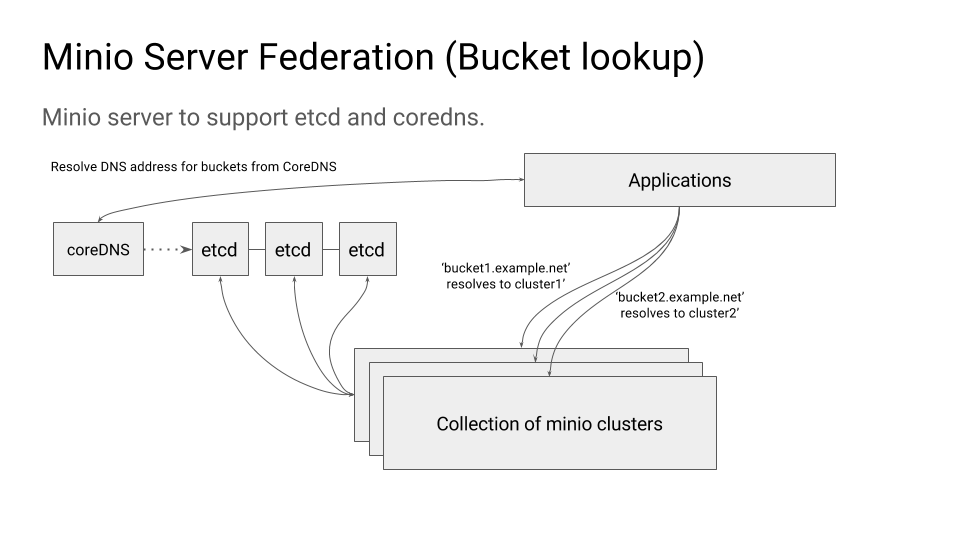- Sort Score
- Result 10 results
- Languages All
Results 1 - 10 of 25 for Beavers (0.23 sec)
-
docs/federation/lookup/README.md
 ### Environment variables #### MINIO_ETCD_ENDPOINTS This is comma separated list of etcd servers that you want to use as the MinIO federation back-end. This should be same across the federated deployment, i.e. all the MinIO instances within a federated deployment should use same etcd back-end. #### MINIO_DOMAIN
Plain Text - Registered: Sun Apr 28 19:28:10 GMT 2024 - Last Modified: Thu Sep 29 04:28:45 GMT 2022 - 4K bytes - Viewed (0) -
docs/bucket/notifications/README.md
``` MinIO supports all the exchanges available in [RabbitMQ](https://www.rabbitmq.com/). For this setup, we are using `fanout` exchange. MinIO also sends with the notifications two headers: `minio-bucket` and `minio-event`. An exchange using the type "headers" can use this information to route the notifications to proper queues.
Plain Text - Registered: Sun Apr 28 19:28:10 GMT 2024 - Last Modified: Thu Jan 18 07:03:17 GMT 2024 - 84K bytes - Viewed (2) -
okhttp-tls/README.md
Recommendations --------------- Typically servers need a held certificate plus a chain of intermediates. Servers only need the private key for their own certificate. The chain served by a server doesn't need the root certificate. The trusted roots don't need to be the same for client and server when using client authentication. Clients might rely on the platform certificates and servers might use a private
Plain Text - Registered: Fri May 03 11:42:14 GMT 2024 - Last Modified: Sun Dec 17 15:34:10 GMT 2023 - 9.1K bytes - Viewed (1) -
docs/security/README.md
## Server-Side Encryption MinIO supports two different types of server-side encryption ([SSE](#sse)): - **SSE-C**: The MinIO server en/decrypts an object with a secret key provided by the S3 client as part of the HTTP request headers. Therefore, [SSE-C](#ssec) requires TLS/HTTPS. - **SSE-S3**: The MinIO server en/decrypts an object with a secret key managed by a KMS. Therefore, MinIO requires a valid KMS configuration for [SSE-S3](#sses3).
Plain Text - Registered: Sun Apr 28 19:28:10 GMT 2024 - Last Modified: Sat Feb 12 00:51:25 GMT 2022 - 13.8K bytes - Viewed (0) -
docs/kms/README.md
``` export MINIO_KMS_AUTO_ENCRYPTION=on ``` ### Verify auto-encryption > Note that auto-encryption only affects requests without S3 encryption headers. So, if a S3 client sends > e.g. SSE-C headers, MinIO will encrypt the object with the key sent by the client and won't reach out to > the configured KMS. To verify auto-encryption, use the following `mc` command: ```
Plain Text - Registered: Sun Apr 28 19:28:10 GMT 2024 - Last Modified: Thu Jan 18 07:03:17 GMT 2024 - 7.1K bytes - Viewed (0) -
internal/grid/README.md
# MinIO Grid The MinIO Grid is a package that provides two-way communication between servers. It uses a single two-way connection to send and receive messages between servers. It includes built in muxing of concurrent requests as well as congestion handling for streams. Requests can be "Single Payload" or "Streamed". Use the MinIO Grid for: * Small, frequent requests with low latency requirements.
Plain Text - Registered: Sun Apr 21 19:28:08 GMT 2024 - Last Modified: Thu Jan 18 07:03:17 GMT 2024 - 9.4K bytes - Viewed (0) -
okcurl/README.md
Plain Text - Registered: Fri May 03 11:42:14 GMT 2024 - Last Modified: Sat Jul 09 21:19:04 GMT 2016 - 178 bytes - Viewed (0) -
docs/bucket/retention/README.md
``` ### Set object lock PutObject API allows setting per object retention mode and retention duration using `x-amz-object-lock-mode` and `x-amz-object-lock-retain-until-date` headers. This takes precedence over any bucket object lock configuration w.r.t retention. ```sh
Plain Text - Registered: Sun Apr 28 19:28:10 GMT 2024 - Last Modified: Thu Sep 29 04:28:45 GMT 2022 - 3.9K bytes - Viewed (0) -
docs/metrics/prometheus/README.md
- MinIO exports Prometheus compatible data by default which is bucket centric as an authorized endpoint at `/minio/v2/metrics/bucket`. This document explains how to setup Prometheus and configure it to scrape data from MinIO servers. ## Prerequisites To get started with MinIO, refer [MinIO QuickStart Document](https://min.io/docs/minio/linux/index.html#quickstart-for-linux). Follow below steps to get started with MinIO monitoring using Prometheus.
Plain Text - Registered: Sun Apr 28 19:28:10 GMT 2024 - Last Modified: Fri Apr 12 15:49:30 GMT 2024 - 7.1K bytes - Viewed (0) -
docs/throttle/README.md
Example: Limit a MinIO cluster to accept at max 1600 simultaneous S3 API requests across 8 servers, and set the wait deadline of *2 minutes* per API operation. ```sh export MINIO_API_REQUESTS_MAX=1600 export MINIO_API_REQUESTS_DEADLINE=2m export MINIO_ROOT_USER=your-access-key
Plain Text - Registered: Sun Apr 28 19:28:10 GMT 2024 - Last Modified: Sat Feb 12 00:51:25 GMT 2022 - 2.4K bytes - Viewed (0)